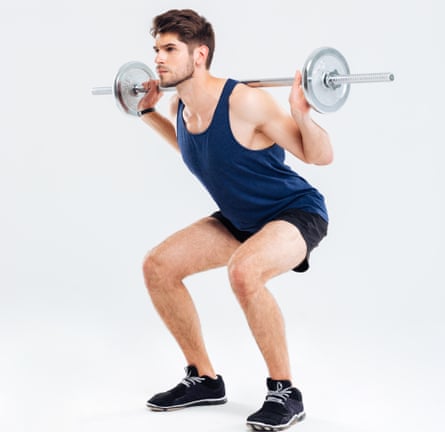Introduction
There has always been a controversial claim about squat workouts stunting your growth and eventually making you shorter. For those who haven’t heard of this, then welcome to this famous (or perhaps, infamous?) workout myth.
Though it may sound convincing, the confusion still lies whether this is a fact or not. This has always been an ongoing claim in the strength training community and I honestly didn’t know about this until I came across this on the internet.
As I research more on squats and their drawbacks and whatnot, I’ve figured some scientific research that might actually be helpful in understanding the workout and also how your body works. So, do squats make you shorter? Read on to find out!
The Benefits Of Doing Squats
Squats have always been part of everyone’s workout routine. Your leg day or your strength training routine will never be complete without doing some squats.
 Of course, I totally understand if you can’t do squats because of your knees. But, more often than not, doing squats is pretty beneficial for most because of how it strengthens and shapes your lower body area. Knee sleeves for squats can often help with that.
Of course, I totally understand if you can’t do squats because of your knees. But, more often than not, doing squats is pretty beneficial for most because of how it strengthens and shapes your lower body area. Knee sleeves for squats can often help with that.
Did you know that doing squats has a ton of benefits, other than giving you the perfectly shaped glutes?
Squats can help you burn your calories fast since you will be building muscle, hence, it can burn your calories. Adding weights can help too!
For mobility and balance, squats can contribute some benefits to these. Since you need strong legs to stay mobile as you get older, squats come into play with strengthening these.
Leg and core strength and stabilizing muscles are just some of the few muscle groups that squats are focusing on. Also, you can’t forget thighs and glutes!
Postural improvements are also part of the many benefits that squats bring. Since you will have an improved core and leg strength, it is more likely that your posture is next. This is because the muscles in your front back will work together.
In short, there are tons of benefits and advantages squats can bring. Hence, suggesting to skip squats, because it is deemed to make you shorter, can be pretty tricky and difficult.
"Contreversial" Claims Debunked
To put it simply, doing squats do not have any negative effects on your height or growth. This is a myth and probably a past study that lacked crucial evidence. Nevertheless, it does not cause any vertical growth problems.
Some may say that this could affect in correlation, however the science field is still concluding on that matter. This is because growth can be affected by so many factors. Hence, concluding it instantly would be improper research.
To know more as to why squats do not affect your vertical measurement nor make you shorter than your original height, read on, and learn more. Take note though that there could be some little exceptions to this debunked myth. Keep reading.
Growth Plates
The explanation about this can be pretty science-heavy, but please bear with me. This may sound a bit too complicated but trust me, it’s pretty comprehensible.
Take note that you have growth plates in which your new bone growth takes place. This is located at the ends of your bone structure and they’re made up of cartilage.
When you’re young and still growing, you can expect that these are still growing. However, if you’re done growing, these plates harden and form into a more solid bone.
These happen naturally and they stop growing because of age and because of genes. Hence, no matter what you do, you can’t spontaneously impede your growth through weight lifting and squats.
In short, squats do not have any negative impact on your height. Hence, you don’t have to worry about becoming short after multiple squat reps and sets.
In fact, according to Quatman et al. (2009), lifting weights or doing squats, in general, may have a contribution to your overall growth potential. This is possible when you’re observing the safe and right ways of doing the workouts.
By safe and right ways, I mean proper breathing, effective warm-up, and correct stance width. And if you’re only beginning to do squats or squats with heavy lifting, you must be guided by someone who knows how to do it effectively.
Generally, doing squats doesn’t get any controversies with it impeding your growth, doing squats while heavy lifting does. However, regardless of the two activities, these won’t really affect your growth.
Heavy lifting while doing squats or just doing squats, in general, won’t decrease or negatively affect your overall vertical growth. However, they can actually have a negative impact if not done correctly—and the worst-case scenario is an injury.
Spinal Reduction
There’s one research that actually suggests that squats can affect one’s growth through its spinal reduction. However, this is very minimal, temporary, and it can only reduce your height by a few millimeters or less.
It is believed that this will happen when people who are religiously doing squats are heavy weight lifters who use weightlifting belts. However, other than that, this is not a big issue to keep your focus on.
If you do not know, shrinkage in your spinal column can have a positive association with your body. This means that you have built up your strength, hence you can observe an increase in your power.
Your spinal discs are elastic. Thus, the shrinkage of these is minimal and also temporary. You can trust your natural bodily process to take care of the little things within you, so don’t worry too much!
Now that we’ve established the fact that this will not permanently affect your height. I can now say that doing squats may actually help you look taller. Nope, it won’t give you that desired tall height, but it can help you look tall.
The weightlifting training sessions will positively affect your back muscles. It is known that these muscles support your spine and thus, it will positively affect your posture.
In short, a better posture and a good back muscle will make you look taller. This all thanks to your squats!
Squatting and Disorders
Don’t get me wrong, though. As I write this debunking of a squatting myth, I immediately had an assumption that you have no bodily complaints nor disorders.
When you’re suffering from a spine curvature disorder like kyphosis or lordosis, this can negatively affect your height. Any problems like weak abdominal muscles and hamstrings can also be hindrances.
When you’re compressing your spine through your workouts, and that includes squats too and heavy lifting, you’re negatively affecting your body if you’re suffering from the said disorders. Thus, make sure to inquire with your doctor or therapist first before making a move (literally!).
Proper Ways To Do Squats
It is important to properly do all your workout routines, and that includes your squat workouts. Though this may seem easy and doable, it’s still important to take note that the little things matter.
Just like any workout, it is important to consider that you must do a warm-up before anything else. This will help you prepare and condition your body and your muscle groups before engaging in an exhausting workout.
When working out, you should take note that it is important to balance your training sessions. Meaning, you should not just be doing squats because just like anything, when not taken into moderation, this can be counterproductive.
You should also focus on other types of exercises. Meaning, you should consider Pilates, aerobic exercises, and a lot more. Strength training, like squats, may excessively stress and wear your muscles.
The Proper Squat
To properly do squats, always begin with by standing with your feet flat on the floor. Make sure that they’re shoulder-width apart and your feet are parallel with each other.
Secondly, put your hands on your thighs, look straight, and lift your chest up. Make sure that you’re observing proper posture when doing squats to make it more effective, comfortable, and safe.
Bend your knees as you put your weight on your heels. When you bend down, make sure that you’re mimicking a sitting position. Hence, make sure that you slightly sit back.
Slide your hands down your thighs. For a basic and regular squat, make sure that your elbows reach your knees. For other types of squats like sumo and deep squats, the hand position and the width of your feet can vary.
Make sure that when you bend your knees, they don’t go beyond your toes. Meaning, everything should be properly aligned—or else, they won’t be as effective. Your head and chest must be upright too.
You can hold the position for 3-5 seconds, or depending on the workout you’re doing. After, you rise back upwards by pressing your soles down the ground for support.
With all these steps in mind, you can repeat this process 10 to 20 times. You can also change the reps and sets depending on your workout routine.
As you do all these steps, don’t forget to watch out for your breathing pattern. So, when you squat, make sure to take a deep breath in. And as you go back to your original position, breathe out the air.
Otherwise, check out this great video by one of our favorite bloggers, Nerd Fitness:
Conclusion:
Always take note that your height can change and fluctuate because that is the natural occurrence of your body. But, don’t ever think again that you can’t do squats because it will affect your height.
Your growth won’t be stopped or be affected by heavy lifting and doing squats. You will grow if you can still grow. Hence, nothing can really stop you…so what are you waiting for? Get out there and do some squats!
If you’re suffering for bad knees, then check out these cardio workouts we did a post on to help with that. Possibly as you progressively get stronger, you can start doing squats as well. However always make sure to check with your healthcare physician first before making any drastic changes to your training regime. If you’re looking for more ways to spice up training at home, then why not check out our guide on what the best home gym essentials are.
Sources:
https://www.urbanfitness.com.au/blog/exercise-optimal-health/12-benefits-of-squats

Marko Rakic is a trail runner and fitness enthusiast from Sydney, Australia. He is the lead writer for The Ultimate Primate and believes the best way to live a happy life is through constantly challenging yourself.
